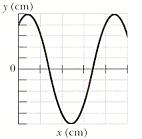Sinusoidal transverse wave
The Transverse Wave
A sinusoidal transverse wave is traveling along a string in the negative direction of an x axis. The figure below shows a plot of the displacement as a function of position at time t = 0. The x axis is marked in increments of 20 cm and the y axis is marked in increments of 0.5 cm. The string tension is 4.4 N, and its linear density is 25 g/m.

(a) Find the amplitude. m
(b) Find the wavelength. m
(c) Find the wave speed. m/s
(d) Find the period of the wave. s
(e) Find the maximum speed of a particle in the string. m/s
(f) Complete the equation describing the traveling sinusoidal transverse wave, in which x and y are in meters and t is in seconds.
y(x, t) = sin( ?x + ?t + ? )
Answer
The amplitude of the sinusoidal transverse wave is the maximum elongation from the x axis: $A = 5*0.5 cm = 2.5 cm$
and its wavelength is the distance between two consecutive maxima $lambda = 4*20 cm =80 cm$
and the wave speed is $v = sqrt{T/mu} =13.266 m/s$
The equation that relates the wavelength to the wave speed is:
$lambda = v*T$ and thus
$T = 0.0603 seconds$ and
$V max = omega*A =(2*pi/T)*A =(2*pi/0.0603)*0.025= 2.605 m/s$
The equation of the wave traveling in positive x direction is
$Y(x,t) = A*sin[2*pi*(x/lambda -t/T) +phi]$
The equation of wave travelling in the NEGATIVE x direction is
$Y(x,t) = A*sin(2*pi*(-x/lambda -t/T) +phi) = A*sin[2*pi(x/lambda +t/T) +phi]=$ $=0.025*sin(7.85*x +104.2*t +phi) meter$
From the initial conditions at $t=0$ (from the picture) we can determine the phase $phi$
$0.02 =0.025*sin(phi)$ $phi = 53.13 deg =0.927 rad$
Therefore the equation of this wave is
$Y(x,t)= 0.025*sin(7.85x +104.2t +0.927)$
You can continue reading a discussion on transversal waves at physics forums

